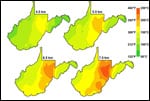Should global warming cause sea levels to rise as predicted in coming decades, thousands of archaeological sites in coastal areas around the world will be lost to erosion.
With no hope of saving all of these sites, archaeologists Leslie Reeder of Southern Methodist University, Torben Rick from the Smithsonian Institution, and Jon Erlandson of the University of Oregon have issued a call to action for scientists to assess the sites most at risk.
Writing in the Journal of Coastal Conservation and using California’s Santa Barbara Channel as a case study, the researchers illustrate how quantifiable factors such as historical rates of shoreline change, wave action, coastal slope and shoreline geomorphology can be used to develop a scientifically sound way of measuring the vulnerability of individual archaeological sites.
They then propose developing an index of the sites most at risk so informed decisions can be made about how to preserve or salvage them.


